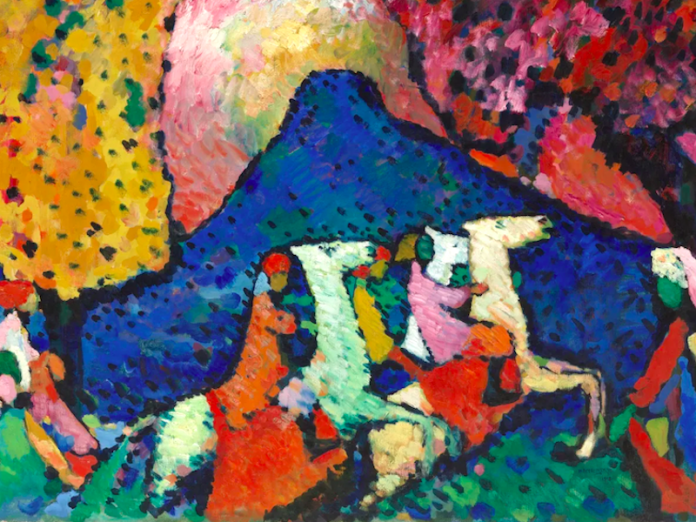Kandinsky is an artist famous for his bright colours and bold abstract forms. While many may have seen a few of his best-known paintings, it is rare to be able to appreciate his body of work in its complete and vibrant glory.
The Art Gallery of NSW’s latest show, simply entitled ‘Kandinsky’, is a retrospective exhibition that showcases Kandinsky’s works from the Solomon R Guggenheim Museum in New York. As the largest Kandinsky collection to be held in Australia, it is a breathtaking display that spans the painter’s entire artistic life.
Born in 1866 to a wealthy family of Moscow tea merchants, Vasily Kandinsky seemed destined to follow a conventional path. However, at age 30, Kandinsky experienced an intense revelation after attending a Richard Wagner opera. The opera opened his eyes to the power of art to touch and transform the soul. Seemingly overnight, Kandinsky abandoned his budding legal career in Moscow and decided to dedicate his life to finding an artistic medium that could spark a similar emotional response in his own audience.
On entering the exhibition I first noticed the openness of the space. Unlike other retrospective shows that aim to box an artist’s life into distinct chapters, it was clear this exhibition wanted to showcase Kandinsky’s development in a more organic way. Although the 47 paintings on display were placed in a loose chronological order from Kandinsky’s early more representational works through to the height of his abstract experimentations, the absence of dividing rooms allowed viewers to make their own observations on how his style transformed.
This ingenious use of space also encouraged viewers to appreciate the connections between the classical style of his early works and the freewheeling experimentations of his later paintings. Such connections, including the recurrence of Russian folk motifs, are often overlooked in Kandinsky’s case in favour of highlighting the dramatic twists and turns his artistic life seemed to follow.
The rich oil colours of the opening paintings immediately swept viewers into Kandinsky’s magical world. These works, completed in rural Germany during the early years of the 20th century, demonstrate Kandinsky’s enduring interest in spiritualism and Russian folk culture. The most famous example of this interest is most famously manifested in Kandinsky’s Blue Mountain, where the motif of the horse rider can be seen for the first time.
For Kandinsky the rider symbolised spiritual freedom and recurs several times throughout his paintings, although in different forms. It was clear from the crowd gathered around this painting that I was not the only one who found the childlike simplicity and electric colours of the work alluring.
As I walked through the exhibition, the paintings gradually became more abstract. The once distinct subjects, such as his famous horse rider, began to take on more symbolic forms. Abstractionism emerged in the early 20th century, characterised by a rejection of the long held belief that art must represent a narrative. Instead, artists of this movement, like Kandinsky, experimented with colour and form to create works that speak to their viewers’ emotions more than their intellect.
At first glance, Kandinsky’s abstract paintings seemed chaotic and improvised. But, after spending a few minutes with these works, especially Kandinsky’s Composition 8, I began to realise there was great precision and technique beneath the surface.
Far from improvisational, it was clear that every line, colour and object in this work had been carefully planned. The soft curved shapes dotted throughout the work are balanced against the harsh lines and triangles, while the pastel pinks and yellows are paired perfectly with deeper blues and reds.
What I found especially interesting in this more abstract phase of the exhibition was overhearing the observations of the viewers around me. Every person saw something new in each painting and was affected by the colours and shapes in different ways. These excited whispers and gasps of delight proved that, even a century on, Kandinsky’s paintings continue to cause “vibrations in the soul”, as he would have said.
A rare opportunity for Sydneysiders to see Kandinsky in full view, this exhibition expertly brings his magical visions to life in a way that will prove an equal delight to those long acquainted with the artist and those discovering his work for the first time.
- ‘Kandinsky’ is showing now at the Art Gallery of NSW until 10 March 2024.


